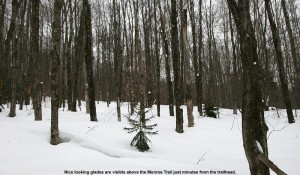
From what I’d been hearing, ski conditions were generally decent around the area this week, but new snowfall was sparse. Subsequent to the 9 inches of snow that Bolton picked up last weekend, they’d only reported 2 to 3 inches of additional accumulation. Down at the house in Waterbury (495’), we picked up 4.8 inches of snow from that weekend event, and then smaller events on Monday and Wednesday dropped 1.2 inches each. It was enough to keep things fresh, but it was rather dry snow that probably didn’t add too much new substance to the snowpack.
The end of the week also saw an increase in temperatures, with our location in the valley getting up to around 40 F at times. It was a little hard to get a sense of what had gone on with the weather in the mountains, since I heard talk of a crust in the Mt. Mansfield area, but Paul Terwilliger’s report from Central Vermont suggested that the powder was great down there. Unsure of whether I was going to encounter, powder, crust, mush, or who knows what, I chose to keep it simple and earn some turns close to home. I decided to check out some terrain right across the Winooski in North Duxbury below Camel’s Hump. From the Winooski Valley, at an elevation of about 400’ or so, the Camel’s Hump Road heads southward up into the mountains for several miles to an elevation of about 1,500’ where there is access to Camel’s Hump State Park and various hiking trails. My friend Weston used to live right up near the top of the road, and told me that there were plenty of glades up above him along the route to Camel’s Hump. I took a peek at my copy of David Goodman’s backcountry skiing book for Vermont, and he also speaks of the various glade skiing options along the Monroe Trail.
 This was actually my first time driving up Camel’s Hump Road in the winter, so it was neat to get the perspective with the snow. The drive offered great views of Ridley Brook, which flows near the road throughout the drive. I always get a kick out of some of the funky houses along the road: some that seem to be accessed by unique bridges, and others with their own quirks, like one that seems to be some sort of partially underground structure with a flat roof. At this time of the year, the very top part of the road is closed, so I had to park in the winter parking area at ~1,200’. From a temperature of ~38-39 F down at the house, the temperature dropped to ~36 F at the parking area, and in terms of snow conditions, I hoped that the temperature would continue to drop as I ascended.
This was actually my first time driving up Camel’s Hump Road in the winter, so it was neat to get the perspective with the snow. The drive offered great views of Ridley Brook, which flows near the road throughout the drive. I always get a kick out of some of the funky houses along the road: some that seem to be accessed by unique bridges, and others with their own quirks, like one that seems to be some sort of partially underground structure with a flat roof. At this time of the year, the very top part of the road is closed, so I had to park in the winter parking area at ~1,200’. From a temperature of ~38-39 F down at the house, the temperature dropped to ~36 F at the parking area, and in terms of snow conditions, I hoped that the temperature would continue to drop as I ascended.
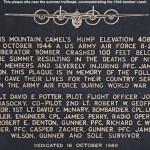 With skins on, I quickly made it up the rest of the snow-covered road to the main parking area and trailhead at around 1,500’. I checked out the plaque near the trailhead commemorating the 1944 bomber crash on the mountain, and then I was on my way up the trail. I began checking the consistency of the snow, and it seemed like the powder was dense, but not really wet, and there was no detectable crust. Within a few minutes of being on the Monroe Trail, I began to see obvious glades up above me as Weston had suggested. The Monroe Trail didn’t really attack the fall line, instead it seemed to gradually contour up and to the left in a southwesterly direction. I figured that one approach to skiing the glades would be to see if I could gain some elevation on the Monroe Trail and eventually traverse back in a northeasterly direction for a fall-line style descent back to the trail, but I wanted to see where the Monroe Trail would take me on its own before I started breaking snow on a new route. The trail was well packed, and plenty wide as David Goodman suggests in his book, so it’s really easy to cruise along with skins. I was happy to have full-width skins in a few spots where the trail gets steep, but one could certainly make due with less as long as the snow consistency supported good grip. There were a few ski tracks where skiers had come out of some of the glades, and tracks suggested that a few more folks seemed to have skied on and around the trail, but I didn’t see any skiers during my tour. I did see a lot of people on snowshoes: one group of 6 to 8 people, a few couples, and a couple of other groups.
With skins on, I quickly made it up the rest of the snow-covered road to the main parking area and trailhead at around 1,500’. I checked out the plaque near the trailhead commemorating the 1944 bomber crash on the mountain, and then I was on my way up the trail. I began checking the consistency of the snow, and it seemed like the powder was dense, but not really wet, and there was no detectable crust. Within a few minutes of being on the Monroe Trail, I began to see obvious glades up above me as Weston had suggested. The Monroe Trail didn’t really attack the fall line, instead it seemed to gradually contour up and to the left in a southwesterly direction. I figured that one approach to skiing the glades would be to see if I could gain some elevation on the Monroe Trail and eventually traverse back in a northeasterly direction for a fall-line style descent back to the trail, but I wanted to see where the Monroe Trail would take me on its own before I started breaking snow on a new route. The trail was well packed, and plenty wide as David Goodman suggests in his book, so it’s really easy to cruise along with skins. I was happy to have full-width skins in a few spots where the trail gets steep, but one could certainly make due with less as long as the snow consistency supported good grip. There were a few ski tracks where skiers had come out of some of the glades, and tracks suggested that a few more folks seemed to have skied on and around the trail, but I didn’t see any skiers during my tour. I did see a lot of people on snowshoes: one group of 6 to 8 people, a few couples, and a couple of other groups.
The trail continued it’s mostly gradual, southwesterly ascent, and at around 1,800’ I noticed that the trees seemed to have more brush in them than I’d seen in the earlier part of the climb. At 2,300’ in elevation, I reached the junction of the Monroe and Dean Trails, and direction-wise, continuing on the Monroe Trail was the obvious choice for what I wanted to ski. The Monroe Trail had been starting to wrap around toward a more northwesterly direction, getting more in line with my efforts to eventually head to the northeast, while the Dean Trail headed southwest. Not far above the junction, the forest began to turn into a beautiful combination of birches and evergreens, and I could see some nice ski lines for folks that opted for the skiing in the trail area. Then, a little above the 2,500’ elevation mark, I hit the frost line and everything began to turn white, changing the look of things again. Ascending farther, the forest transformed back into more hardwoods again with some decent open ski lines paralleling the trail, and I could see that a few people had used them. Finally, as I approached the 2,800’ level, the trail was actually starting to almost make a north/northeasterly jog and far above I could see huge cliffs on the eastern face of Camel’s Hump directly ahead of me. The forest quickly transformed yet again into an area of almost exclusively evergreens.
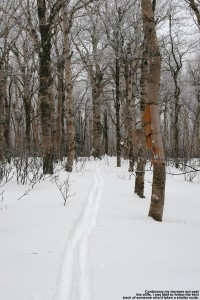
It was after 3:00 P.M. by that point, and as I didn’t want to push the available daylight, I began to look for the best route to traverse northeastward for my descent. I followed the Monroe Trail for as far as it seemed to jive with my plan, and when it really seemed to head southward I had to begin my traverse. I traversed north/northeastward among the evergreens, and down below the cliffs the trees were often quite open. If the snow was elevation-dependent, or if one wanted to simply stick in this terrain, I could easily see this area being used for some great laps of skiing. Indeed, I saw various tracks of previous skiers scattered around, suggest that folks had had some fun. As I made my traverse through the evergreen forest, I came across various tracks of people that had either been descending or ascending, but I eventually picked up a skin track that seemed to be very much in line with my plan. I followed the track through the evergreens until it broke back out into a lot of birches, crossing what looked like an interesting trail marked with blue flagging tape. That blue-flagged route looked intriguing, but it ran literally perpendicular to where I wanted to go, so I had to pass it by and chock it up to future exploration. I checked several times with my GPS compass to ensure that the track I was following was legitimate, and not something left over by somebody that had simply been lost, but it stayed on course.
After another couple of minutes of traveling through some flat, very open terrain, I noticed that the skier/rider before me had started to make a couple of turns, so I decided it was time to take of my skins and focus on the descent. I was excited about the skiing prospects, even if only due to the snow depths and consistency I’d see on the ascent. I had little idea about what I might find for slope continuity or vegetation below. In terms of snow quality, there had been no sign of a crust aside from a couple of isolated spots that had a thin coating that must have been from the sun. And, throughout the trip I’d been checking on snow depths, finding anywhere from 14 to 26 inches of settled powder atop the base snow.
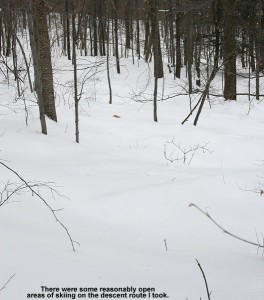
You don’t always know quite how snow is going to ski until you actually get on it, but as soon as I dropped that first knee into a turn all questions were answered. The powder was dense as expected, and I was only sinking in about 4 to 5 inches, but the density made the turns really smooth. I continued on with turns, checking my GPS every couple hundred vertical or so to ensure that I was on track to hit the glades near the start of the Monroe Trail. There were some steeper options off to my left (north) but with the tree spacing they would be best for deeper/lighter powder. I found the conditions perfect for the moderate and low angle slopes that I encountered. Ultimately, my descent was not as fall line as I was initially hoping for, and I really had to keep pulling left throughout the descent to stay on target, but I was pretty happy with it for a first shot. I occasionally saw a couple of other tracks in the area as our paths crisscrossed, so obviously some others (presumably at least that track I’d followed) had done something similar. As far as tree spacing went, it wasn’t a brush-fest, and there were a few more open areas, but nothing extraordinary relative to what I’ve seen around here for what appears to be nature taking its typical course. If one didn’t have to check on or correct their route, most competent tree skiers could enjoy a fairly continuous ride without having to constantly hit the brakes for brush. A couple more feet of base would help a little on the bush front, but not too much from what I could see, and it’s certainly not needed in terms of coverage. With the base snow plus all the settled powder, coverage was absolutely bomber on everything I found on my ascent. I was able to pop off small boulders etc. and never heard a thing from my skis. The most consistently open glades on my descent were the terrain I’d seen down near the Monroe Trail, and I actually still came up just shy of one of the shots I’d been aiming for. Looking at my GPS/Google Earth plot, I can see that a longer traverse up high would be needed for a more direct fall line descent, but that’s something to strive for in a future trip. It does remind me of a quote from David Goodman’s chapter on the Monroe Trail, where he says “The quest for the perfect glade run will keep you coming back to Camel’s Hump time and again…”
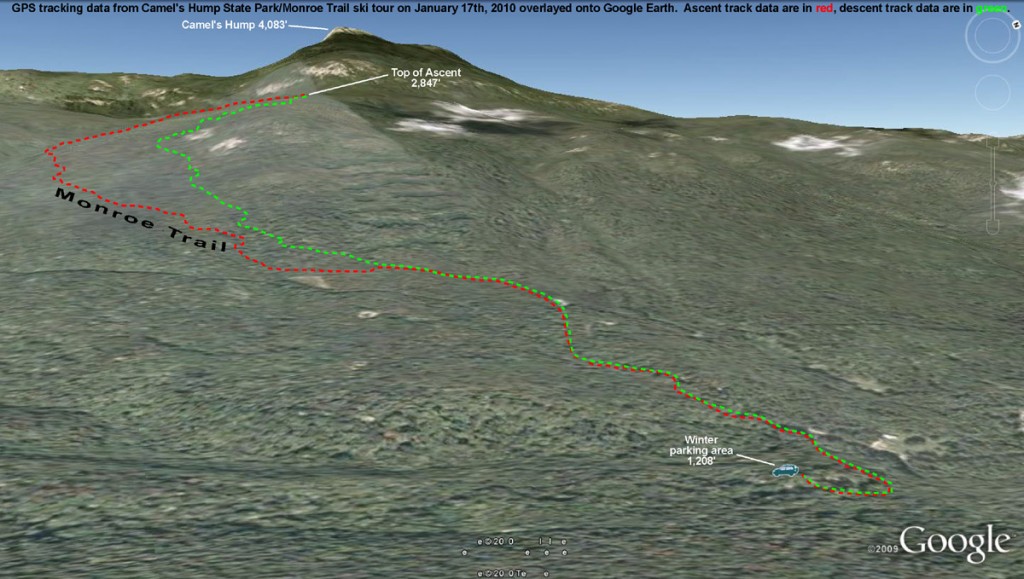
So, both the base and ski conditions in the Monroe Trail section of Camel’s Hump State Park were great as of yesterday at all elevations I skied off piste (1,500’ – 2,800’). We picked up 1.4 inches of snow from last night’s activity, so that area should have picked up something in the 1 to 3 inch range as well, and I can’t imagine that would be anything but a positive on top of the conditions I experienced.











